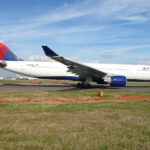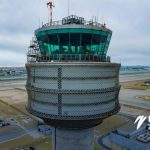Flight tracking platforms drew public attention this Friday (23) to the flights of four Airbus A340s which took off from Johannesburg/OR Tambo (JNB) in South Africa, in a possible transfer of aircraft to Iran.
According to our partner media Aeroin, if confirmed the move could be classified as an evasion of U.S. sanctions.
As reported by Twitter profile @Gerjon_, known for monitoring unusual movements on tracking tools and satellite photos, the four aircraft were previously owned by Turkish Airlines, but were retired in early 2019 and returned to its Hong Kong-based lessor Avro Global. The Airbus A340s were then stored in South Africa since then.
After three years, they were nationalized in Burkina Faso, before flying to Iran. The registration numbers of the TC-JDM, TC-JDN, TC-JIH and TC-JII aircraft were updated to XT-AKK, XT-ALM, XT-AKB, while the fourth could not be identified.
⚠️Super interesting, going on now: 4 ex-Turkish A340s, recently registered in 🇧🇫Burkina Faso as XT-AKK, XT-ALM, XT-AKB and XT-??? currently flying.
The first disappeared over 🇮🇷Iran — known for avoiding aviation sanctions + A340 operator…#MAN3808 #MAN3809 #MAN3810 #MAN3811 pic.twitter.com/7YgVku8Dyk
— Gerjon | חריון | غريون | ኼርዮን (Deactivated) (@Gerjon_) December 23, 2022
Not the first time that Iran acquires aircraft through illegal means
In turn, another profile, @BabakTaghvaee1, dedicated to intelligence reports, tweeted about Turkey’s possible involvement in evading U.S. sanctions. Those sanctions prevent the export of equipment to Iran if it contains U.S.-produced inputs. In the case of Airbus aircraft, systems and components produced in various parts of the world are used, including U.S. equipment and intellectual property.
At this time, it is not possible to substantiate the allegation of aid to Iran or who is behind the transfer of aircraft. It is known that the Persian country is facing severe problems with its aviation, with aging aircraft as it is unable to buy new ones from Western manufacturers, as well as more than a hundred aircraft idle for lack of spare parts.
Easily identified on the ground at JNB. Red tail, and registry on top of the right wing. pic.twitter.com/ZIlWyZvEhN
— Ruben Hofs (@rubenhofs) December 23, 2022
To obtain more aircraft to meet passenger demand or serve as a source of spare parts, the Iranians have for decades turned to the help of countries willing to stand up to U.S. sanctions. If these aircraft are seen in the future, it will be possible to better understand why they flew this weekend to the Islamic Republic.
At the beginning of 2021, A Boeing 737-300 with the registration EK-FAA of Fly Armenia Airways was performing a technical flight between Estonia and Yerevan, Armenia. But for unknown reasons it ended up in Iran making an emergency landing, and then was never heard from again.
The Aviation Committee of Armenia was alerted about a suspected hijacking of the Boeing and launched an investigation, together with the airline, to find out the whereabouts of the aircraft. According to the Facebook account of the Armenian Prime Minister, Hakob Tshagharyan, the fact was notified by his counterpart from the United Arab Emirates.
The aircraft had a change of flight plan during its route to Ukraine: they decided to head to Sharjah, United Arab Emirates, with the excuse that scheduled maintenance was to be carried out there. According to Tshagharyan, the Boeing ended up in Tehran after declaring an emergency.
After a few days, in the midst of the chaos over the Boeing 737, it was surprisingly reported that Iran’s Caspian Airlines «acquired» the aircraft.
Iran continues to add aircraft despite sanctions
There was another situation in which Iraq-based Al Naser Airlines validated a purchase for four Airbus 340s in 2015. The aircraft were fulfilling a flight between Baghdad and Kazakhstan for maintenance, then declared an emergency and landed in Tehran.
See Also: A Venezuelan Boeing 747 with ties to Iran is detained in Argentina
However, a few weeks later, those same Airbus 340s began sporting the colors of Iran’s second largest carrier, Mahan Air.
A controversial case was to use other airlines to channel the aircraft transaction. Two Kyrgyz companies, which are currently sanctioned by the European Union, had notified that they would incorporate certain aircraft that later ended up on Iranian soil. These include Airbus A310s and Airbus A300s that several companies in Iran own.
Recently, a significant number of ERJ 145 and Boeing 737 aircraft have entered Iran with identical cases to the Airbus A340-300, where they were registered to a Burkina Faso company and delivered to the Persian country.
We will soon know and see if the Airbus A340s appear in the colors of some of the twelve registered Iranian companies.















They might need them to escape before becoming No-fly zone..